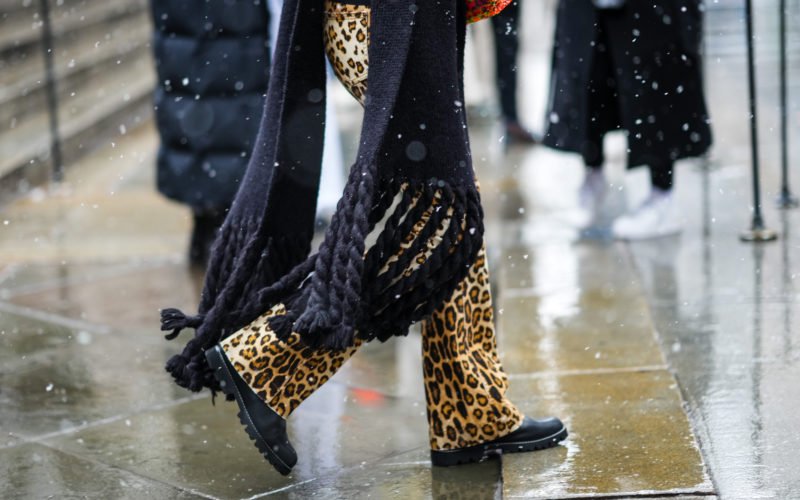
Photography by Getty Images
Say goodbye to damp socks and salt stains for good.
By FASHION Staff
Date January 9, 2023
This article was originally published in January 2016.
There are a few great things about winter: snow bunny chic, snow-tipped mountains for snowboarding, roaring fires and an endless supply of hot chocolate. But with the cold comes ugly snow pants, cracked hands, salt stains, wet boots and tons of static cling. While there’s no avoiding most of these things, at least there’s something we can do about them. See below for winter survival tips that will help you keep up with everything Mother Nature can throw at you this frigid season.
How to get rid of salt stains
With snow comes salt. There’s no avoiding it, and our suede shoes take the hardest hit. Here’s the easiest way to handle those white chalky stains: First, wipe the stain with water and a soft rag as quickly as possible. If it’s fresh, this might work on its own. If you need more heavy-duty removal, moisten a rag with a mix of one part water and one part white vinegar, and gently wipe the stains again. For the most stubborn stains, straight vinegar will do the trick. Finish by wiping the whole area with a clean cloth to remove any residue and let them air dry completely (stuffing the toes with newspaper will help dry them even faster). Prevent further damage by spraying shoes and boots with a winter-weather leather protector.
How to banish wet boots forever
Cold toes can put a damper on your whole day. If your feet are getting wet, make sure that your boots are completely waterproof and have a tight seal (Uggs need not apply). Any damage will have the wet stuff streaming in. To properly dry wet winter boots, avoid the dryer and direct heat (like radiators) completely and stuff them with crushed newspaper to absorb the moisture. For best results, replace the paper every few hours to suck up the most water. You can also put them in front of a fan for a quicker air dry.
How to deal with socks that slip into boots
Slipping socks are the worst. Buried inside your boot, it’s brutal having to walk on a lump of scrunched down sock, stopping to pull them back up to their rightful place. To avoid the slide altogether, make sure your socks fit snugly. A tighter fit and a style with a larger elastic cuff will help keep them in place (old, worn out socks could be your biggest issue). Another way to manage the slip is to wear taller socks and fold them right over the top of your boots. Problem solved.
How to beat static cling
Taking off your coat only to realize your dress is glued to your legs or plucking off your hat and finding a halo of fine hairs are classic winter hallmarks. Come January, there isn’t enough Static Guard on the planet to save us. There’s got to be a better solution. Get to the root of the problem by raising the moisture levels in the air. A portable humidifier (or even just adjusting the settings on your air conditioner) will often do the job — and save your skin in the meantime. Speaking of which, keeping skin hydrated is key. Synthetic fibres are also more prone to holding static charge (sorry, polyester!) so it’s best to swap in natural fabrics like cashmere or cotton. On a final note, wool is an excellent conductor so steer clear of wool socks and stick to cotton instead.
How to layer expertly for warmth
On the extra chilly days, it seems like you’d have to run in your parka to stay warm, but with a few tips, you can actually get out the door without looking like an arctic explorer. Start with a base layer. Any synthetic (like DryFit or polyester) will help to wick moisture from the skin directly. Next, your insulation layer helps retain heat. Sometimes an extra long-sleeve tee will work, but on really freezing days, this might call for fleece. Finally, your outer layer is the one that will keep out the wind, rain, snow and sleet. Butt coverage is key and so is a hood. Accessories are important too, so stock up on gloves, hat, warm running tights, sunglasses, SPF, water-resistant shoes and moisture-wicking socks. If all else fails, find an indoor treadmill and wait for warmer weather.























![Moneybagg Yo – PLAY DA FOOL [Official Music Video] Moneybagg Yo – PLAY DA FOOL [Official Music Video]](https://i.ytimg.com/vi/q5y5HHUwfBs/maxresdefault.jpg)
![Cardi B – Like What (Freestyle) [Official Music Video] Cardi B – Like What (Freestyle) [Official Music Video]](https://i.ytimg.com/vi/GcNC7YnlhKc/maxresdefault.jpg)